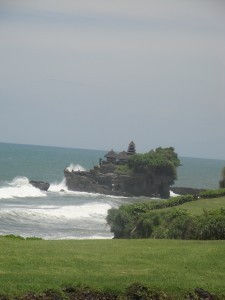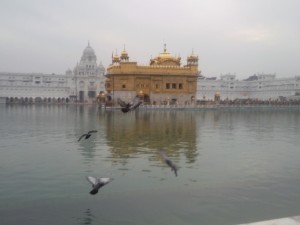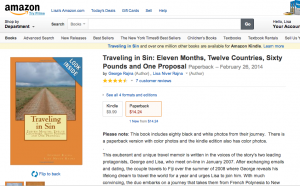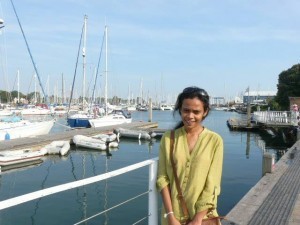Lisa Niver's Blog: We Said Go Travel, page 414
March 4, 2014
Bali, Indonesia Inspires
Landing at the airport, the pagoda columns seem to welcome and herald visitors to behold the natural and man-made wonders of Bali the picturesque island in Indonesia. While the majority of Indonesia’s people are Muslim, in Bali, more than ninety percent professes the Hindu faith of its ancestors. By the end of the first day, it becomes obvious that Bali could be, globally, among the most pious and hallowed tourist spots with the pervasive influence of the Hindu religion on its music, art, dance, temples and way of life.
At daybreak in Bali, the bleary-eyed sleepy tourist scrambling to get some breakfast could very well step on or jump over ‘the offerings’. On the other hand, to the observant tourist these offerings are at first, intriguing and later become an interesting item for they are more than quaint. The ubiquitous offerings are placed at doorways and entrances of homes, hotels, commercial establishments, shops, and street corners. Even a nondescript mobile phone kiosk will have its sacred spot with an offering.
The practice of making offerings is an essential feature in the daily life of the Balinese. It is a form of thanksgiving and offered to appease the spirits, seeking their blessings. Painstakingly prepared by women with attention to detail, they are simple, relatively small, fitting into the palm of a hand. Each offering is unique and contains colorful eye-catching flowers, fruits, vegetables, assortment of food items, all of which are arranged neatly on a handcrafted small tray, the waft and weave pattern deftly created from palm leaf, bamboo, and banana stem. Yet there is a structure and design in the aesthetic array of objects on the square or round trays.
The reverence of the slim batik sarong-clad women in making the offerings, with head bowed and hands folded, is unmistakably devout. The ceremony itself is serenely simple with gentle hand gestures directing the incense fumes towards the statue or object accompanied by graceful body movements that have been handed down over generations. Watching from afar, the spiritual aura of the scene inspires a silent prayer to the creator of the universe even in the atheist.
Bali’s prominent temples are built with black lava stone and orange-red clay bricks, their layered black pagoda roofs and ornamented engraved doorways are inspirational and arouse esoteric feelings. The Balinese consider nine temples very sacred and each has its own special characteristics – their location, what they represent among the Hindu Gods, and historical importance. For instance, Besakhi, the Mother Temple is the most sacred being more than 1000 years old and is situated on the side of the volcano, Mount Agung . Tall geometrically harmonized pillar-like structures, erected on either side at the entrance, are positioned gracefully, classical and elegant, presaging the grandeur and magnitude of the interiors. The mystery of the courtyards at different levels unfolds after climbing about a hundred steps hewn out of black volcanic rock. The most intricate and sacred set of shrines is at the very end accessed after passing through buildings and of course, climbing more steps. To most visitors, the empty platforms in the pillared structures are puzzling with the absence of idols, statues or any physical evidence of worship. The guides offer some explanations. One of them is that the viewer can pay reverence and worship according to his/her inner faith and divinity, inspiring spiritual awe and wonder.
Similarly, the Thanot Lot temple, perched on a rock in the middle of the sea seems almost celestial. Built in the fifteenth century to guard Bali from the sea, it is probably the most famous of Bali’s temples. Literally, Thanot Lot means “Land in the Middle of the sea” and the belief is that it is guarded by poisonous snakes living under it. Fortunately, preservation and restoration work in recent times has saved the temple from the ravages of erosion. The tall pagoda temple surrounded by smaller shrines atop the ragged black rock dotted with a few green trees is picturesque. At high tide, with frothy waves hitting the sides of the rock with thundering sound makes it an ethereal spectacular sight. For some moments, one forgets the earthly world with its ills as the lofty sight inspires deep inner thoughts of peace and tranquillity.
Tourists come to Bali for its beaches, caves, temples, music, dance, paintings, handicrafts and its lush forests bountiful in flora and fauna. But to me, Bali was enchanting for its preserved uniqueness, the harmonious blending of tradition and faith in its modern present, the gentleness of its people, its respect and closeness to nature, conserving its past and gracious beauty. Given all this, Bali will always be a source of inspiration where I could spend time wisely without remorse.
About the Author: Sreelakshmi Gururaja took up writing on retirement from UNICEF after more than 20 years of service. She lives in Bangalore, India and continues to be an advocate for children’s and women’s rights.
Thank you for reading and commenting. Please enter our next Travel Writing competition and tell your story.
The post Bali, Indonesia Inspires appeared first on We Said Go Travel.
Blessed Bliss in Amritsar, India
There is so much one can write about the diverse cultures and places of India. My place of inspiration lies in Amritsar, a city of the Punjab state in India. The name literally means a Pool of Nectar of immortality and is derived from Amrit Sarovar, the holy tank that surrounds the Golden Temple. Golden temple is an informal name for Harmandir Sahib or Darbar Sahib, a prominent Sikh Gurudwara (a place of worship).
Upon entering this holy place, you begin to feel the bliss & serenity in the ambience. In spite of being surrounded by a million souls there is a sense of sweet solitude. The Gurbani (compositions by the Gurus), chanting, the music all warm the cockles of your heart. One thing that touches me the most is the ‘Langar’ (free community meal). It mostly consists of dal (lentil soup), rice, rotis (flat bread), vegetables and at times kheer (rice pudding). This could possibly be the world’s largest free eatery. The practice of langar was started by Guru Nanak Dev Ji (First Sikh Guru). It was designed to uphold the principle of equality between all people of the world on the ethics of ‘sharing one’s blessings.’ Langar also teaches the etiquette of sitting and eating in a community situation, which helps harbour, the feeling of oneness in the society. It is run by sevadars ‘volunteers doing selfless service’ and is served to everyone irrespective of their cast, creed, gender, race or the social status.
Some rules to be followed for this practice are:
The Langar must be:
Fresh and simple vegetarian meal.
The sevadars should wash hands before beginning to cook langar and never taste it while cooking.
The sevadars will normally recite Gurbani and refrain from speaking if possible.
When the Langar is ready, a small portion of each of the dishes is placed in a plate or bowls and is placed in front of the Sri Guru Granth Sahib (The holy book).
The Langar is not eaten until Ardas (prayer) is recited.
After the Ardas is completed, each item of food is returned back to its original pot or container. This is done in a belief that the blessings of the “holy” food are thus passed to everyone through the Langar.
Being a part of this seva (service) in any way transports you to another world. Whether it is peeling the garlic, chopping the vegetables or rolling the rotis you can sense being connected to the divine. You feel blessed that in the journey of food from farm to plate, the almighty chose you to be a tiny medium to feed and nurture a hungry soul. You are a small ring of the chain through which abundance of god’s love is shared. Suddenly your life seems to have a purpose. Perhaps Mohandas K. Gandhi realized it when he said, “The best way to find yourself is to lose yourself in the service of others.” It is really inspiring when you are around people who are spending their time doing something for others. And all the hard work is done without expecting anything in return but blessings of the almighty. You are filled with hope because you know there are people doing acts of kindness all over the world. Despite the fact that they’re only impacting a small part of the society at one time, it is a crucial step in making the world a better place. As they say, “It only takes one person to make a difference”.
The result of investing time here (and not spending) is this blessed feeling of fulfillment. Your mind and heart are full of love, kindness, compassion, happiness, inspiration, hope and pride that there is no room left for regrets whatsoever.
About the Author: I am Daksha Watts from Vadodara, India. Passionate about writing, cooking, making people happy. A newbie traveller who wishes to explore the world. Was Creative Description Service Provider for the Nielsen company for the last 5 years. Now, trying to figure out my calling.
Thank you for reading and commenting. Please enter our next Travel Writing competition and tell your story.
The post Blessed Bliss in Amritsar, India appeared first on We Said Go Travel.
Traveling in Sin is now a PAPERBACK!
Our memoir, Traveling in Sin, is now available in three paperback editions! It turns out most books have very few color photos as they are quite expensive! So we now have FOUR OPTIONS: Kindle e-book with color photos, a paperback with color photos, a paperback with black and white photos and a paperback with no photos. See them all on Amazon! click here
We are publishing three entries from our Inspiration Travel Writing Contest everyday. Our fourth Travel Writing Contest ended on February 14, 2014 with 505 people from 55 countries involved. We will be publishing more entries for all of March and part of April. Read all the stories published so far: Click here. More about when the judging will occur in our next newsletter.
In our four contests, we have had 1043 people from 74 countries participate! Our FIRST travel video contest will begin in two weeks and in May we will start another writing contest on the theme of Independence.
Congratulations to Ken Budd! His article, Holding Elijah, on our site was a finalist in the NATJA awards! See his article for more about the contest and his book!
Recent Articles: Thanks to Dave’s Travel Corner for sharing our Palau story, Two Tickets to Paradise about Carp Island in the Rock Islands and to Alex at Travel Fashion Girl for publishing our story, Chic and Classy Cebu. Nokia and Microsoft recently shared our photo story in their latest Windows Phone Update! See photo below and article: Click here!
We appreciate all of you who read our newsletters, articles, website and BOOK! Thank you to everyone for your support of our journey and all our writing. Connect with us on Facebook, Google+, Instagram, LinkedIn, Pinterest, SlideShare, Twitter, and YouTube.
Lisa and George (Click here to sign up for this newsletter. )
Traveling in Sin: News from this Memoir’s First week! from Lisa Niver Rajna
The post Traveling in Sin is now a PAPERBACK! appeared first on We Said Go Travel.
Reflection in Vietnam
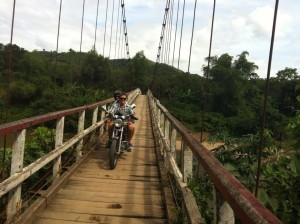 Vivid colours, cheeky smiling faces, fresh spicy aromas and purple sunsets….these are just a few of the reasons to appreciate every single moment in Vietnam. How would I describe Vietnam…..? Unlike any place you’ve ever been!
Vivid colours, cheeky smiling faces, fresh spicy aromas and purple sunsets….these are just a few of the reasons to appreciate every single moment in Vietnam. How would I describe Vietnam…..? Unlike any place you’ve ever been!
Vietnam is one of most diverse, visually breathtaking and magical countries I’ve ever had the pleasure of visiting. My first experience was the bustling streets of Ho Chi Minh City, crammed with motorbikes and rickshaws and incredible street food on every corner. We ventured to the Ben Thanh markets for our first meal of duck salad, rice paper rolls and seared scallops (amazing), then wandered around exploring the incredible fresh seafood, coffee, condiments and produce that lines the alleys. There were some fairly hilarious moments in the city, like when a bunch of Vietnamese ladies spotted some spilled paint on my boyfriend’s toenails and openly laughed hysterically at him, pointing and giggling! You need a new manicure hehehe! And who could forget New Year’s Eve in the city, my partner and I both sitting on top of each other in a one person rickshaw gridlocked in insane motorbike traffic, pushing the wheels along and making ‘Englimese’ banter with our rickshaw driver, later watching a community concert with all the teenagers, families and little kids dancing on tables for the countdown!
Then it was on to Nha Trang, where there is unbelievable amounts of fun to be had at Vin Pearl Resort with its crazy water slides and Eiffel Tower cable car ride! Whilst in Nha Trang we made the decision to go on one of the most meaningful adventures of my life to date! We hired motorcycles and rode for five days from Nha Trang through the winding mountains down to Ho Chi Minh. On our trip we witnessed the most spectacular scenery, enormous rolling mountains in the clouds, miles of lush green rice paddies and stunning waterfalls. We also had the opportunity to experience a taste of Vietnamese culture by visiting isolated mountain communities, temples, pepper and coffee plantations, witnessing how silk and rice noodles are made, even tasting weasel poop coffee (surprisingly delicious), snake and scorpion!
However the culinary highlight for me was our visit to Phu Quoc, a Vietnamese Island just off the South West coast of Vietnam. Phu Quoc is largely national park and very focused on ecotourism, so it is still so untouched compared to many South-East Asian Islands. The beaches are breathtaking with warm crystal clear waters, and flourishing green mountain ranges. Whilst there we learnt that this is actually where a significant amount of Vietnam’s fish sauce and pepper is produced. The scene stealer for me was the incredible night seafood markets, with over 100 stalls where you can buy fresh seafood cooked to order… where the biggest challenge is having enough room to try every sensational dish!
What really remained with me after leaving Vietnam was the unconditional kindness, curiosity and cheekiness that I experienced from the Vietnamese people. The simple lifestyle that many Vietnamese live, and how unbelievably happy they are. Our trip to Vietnam completely changed my perspective on what we need in life to be content. I am the first to admit that I enjoy nice things, and previously somewhat based my self-worth and opinions of others on material belongings. Vietnam opened my eyes to what is truly important, having no regrets about the life you have lived. What I witnessed in Vietnam inspired me to make significant change within my life, and I have decided to rethink my corporate career, and spend (at least!) 12 months travelling South East Asia. I plan to spend time in 13 countries over this period, and dedicate my time to many hardworking charities working with orphans, disabled children and animals. I am leaving with an open heart and open mind, and no commitment to return, so who knows where this journey will take me? If I do have to eventually return, I will certainly not leave with any regrets about how I have chosen to spend my precious time in this life.
About the Author: I am a free spirit who loves travel, food, yoga and meeting new people. I believe life is about finding love, light and fulfillment in all of our adventures.
Thank you for reading and commenting. Please enter our next Travel Writing competition and tell your story.
The post Reflection in Vietnam appeared first on We Said Go Travel.
March 3, 2014
Penang, Malaysia: My Island Hometown
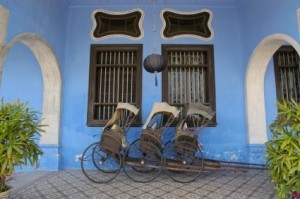 There is only one place in the world that inspires me everytime I go – Penang, my island hometown in the northwestern state of Malaysia. It is a place that I’m so familiar with, having been born in the town of Butterworth in the late ‘80s, yet so foreign all the same, as I have not lived there for a good ten years.
There is only one place in the world that inspires me everytime I go – Penang, my island hometown in the northwestern state of Malaysia. It is a place that I’m so familiar with, having been born in the town of Butterworth in the late ‘80s, yet so foreign all the same, as I have not lived there for a good ten years.
“Let’s get the hell outta here,” I shouted to my friend in the passenger seat of my blue Alfa Romeo. Pinny Girl and I have been best friends since the age of seven, and today we were both out and about in Georgetown, the capital of Penang, looking to chill out at one of those “Best cafés in Georgetown” that we’d read about on other people’s Facebook posts.
Georgetown on the third day of Chinese New Year was not a good idea, but neither of us had any idea. Tourists in their air-conditioned cars both local and from out of town were jamming the narrow alleyways between Love Lane and Stewart Lane, where the oh-so-popular Coffee Atelier was located, and where I had just reversed into a man behind me in a green car.
Tourism has been booming since the city was crowned UNESCO World Heritage Site in 2008. With a lively arts scene comprising museums, art galleries, boutique hotels, an annual heritage festival and just last year, a thriving café culture, it seemed like the whole world had come to see Penang come alive, including us born and bred Penangnites.
Patrons at Coffee Atelier were looking our way, as though watching a drama unfold, as the man from the green car and I stepped out of our vehicles and settled the matter quickly, exchanging numbers and taking photos of the damage on our smartphones. “Call me when you get it fixed,” I told him as I got back into my car, relieved and a little shaken at the same time.
“Let’s find ourselves somewhere that’s not so touristy!” I shouted at Pinny Girl, trying to manouvre my car out of the narrow alley, clearly too clumsy a driver for these heritage backstreets. We both laughed. Pinny Girl and I, like many of the girls in our school, left our beloved island for greener pastures as soon as we finished high school, and are not exactly the savviest of locals in Penang.
Girls like us, after graduating from university abroad, were ready to conquer the world with no plans to return home, only to find ourselves running back to our parents, and to Penang, as the global recession hit in 2008, no graduate programmes were open and our pockets ran dry… all this, only to come back to square one and fall right back in love again with our hometown.
I drive long Campbell Road, and watch with fresh new eyes the old city that I grew up in, with its 19th-century heritage shophouses, some delapitated and in a shambles, some turned into überchic cafés like Coffee Atelier, while some retain its original inhabitants – immigrant families from China, India, the Middle East and their mixed race descendants known as the Peranakans.
I pass by the old man from Hameediyah Restaurant, and the smell of fresh roti waft through my senses, bringing back memories of when my father brought me to nearby Chowrasta Market to look through their collection of second hand books and magazines, and after that to Hameediyah for a fresh plate of chicken murtabak and a cold glass of sirap bandung.
Pinny Girl and I end up eating by the roadside, slurping on a bowl of homemade laksa, a fish broth noodle that is both spicy and sour, and that is only done right in Penang. So much for our afternoon out sitting in the latest Melbourne-inspired hipster café – and a car accident to add to that. We eat in silence, savouring every strip of noodle and every slice of pineapple in the thick tamarind soup.
What’s another latte that I can find in San Franciso, Melbourne or Starbucks, compared to a precious bowl of laksa with my best friend of 20 years. By the time the man in the green car rings me for due payment on the damage done to his car, I would’ve left for Singapore, the city where I currently live and work an hour’s flight away from Penang.
I thought about turning off my phone and breaking my promise to repay him. After all, Penang would be a distant hometown and holiday long gone by then… But when he rings, I will be sure to pick up his call, for it will be a responsibility fulfilled, the call of home, the place where I spend two weeks of my year every year, with no regrets.
About the author: Wan Phing is the Online Editor at AsiaRooms.com. Born and raised in Penang, Malaysia, she has lived in Beijing, London, Benevento, Kuala Lumpur, Manchester and currently resides in Singapore. She loves travel, photography and writing about them on her travel blog.
Thank you for reading and commenting. Please enter our next Travel Writing competition and tell your story.
The post Penang, Malaysia: My Island Hometown appeared first on We Said Go Travel.
Lingering with a Real Spider-Man at the Hoover Dam
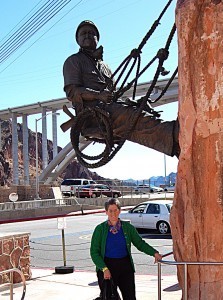 Lingering with a Real Spider-Man at the Hoover Dam
Lingering with a Real Spider-Man at the Hoover Dam
Hollywood’s Spider-Man….. Every moviegoer knows Spidey’s swift, skillful propelling through a cityscape’s skyline as if he were at the end of a yo-yo trick executed by a giant’s hand. But, I have met a real Spiderman, and he is someone to spend time with.
Outside a gift shop at the Hoover Dam (Boulder, Nevada), a statue adorned with ropes, cables, a wooden seat, and a forty-something working man—secure in his domain with goggles on his helmet—hangs off a cliff wall. The statue depicts one of the Dam’s famous High Scalers. These former sailors, circus acrobats, and American Indians repelled down the sides of the Colorado River’s Black Canyon during the early days of the Dam’s construction. Their notable job? Removing the loose rock caused by water freezing in the cracks.
Armed with only ropes, dynamite, pick axes, water bags, and jack hammers lowered to them, the High Scalers ricocheted off the canyon’s walls, sticking dynamite into excess rock to even off the canyon. Then, suspended a couple hundred feet in the desert air, they caromed away from the blast, escaping lethal rocks and ear-blasting explosions. Like modern zipliners, they performed aerobatic stunts for their fellow workers, but only when their supervisors were not watching. It has been said these Spidey men might even have been responsible for designing the first construction hard hats, covering their caps with tar to protect themselves from dropped tools and falling rocks. Paid a mere seventy-five cents a day (a princely sum, though, for Depression America), these audaciously brave men, many of whom died as they scaled the canyon’s walls, were, indeed, High Heroes.
Here, today, I cannot help but stare into the stone-carved face of the High Scaler, whose gaze sweeps over the Dam he helped to construct, a gaze that looks to the future when the Dam— representing the dominating will of man over nature—is still providing water to people in many American and Mexican states. This High Scaler (the statue’s model was supposedly a Joe Kine, the last High Scaler alive when the statute was carved in the 1990′s) may have been just an ordinary Joe, if anyone can be said to be ordinary. But, unlike the Marvel comic Spider-Man, he has no identity crisis; he embodies rugged, determined individualism, and, ironically, confidence and surety during the time of the Great Depression when doubt and uncertainty prevailed. With his legs braced against the cliff wall, he is posed to repel once again.
Another tourist, a slender man pushing thirty, dressed in khakis and dockers, looking more prosperous than the High Scaler could have ever hoped to be during the Depression, stops to search out the meaning of this statue clinging from the cliff’s high wall. The proud bearing of the statue provokes the tourist’s words, “I don’t think we have any men today who could build us such a dam.” Such valor deserves respect. And, even a moment to linger, as my tourist friend and I did, before a true Spider-man.
About the Author: Dr. Bonnie Devet is a Professor of English/Director of the Writing Lab Department of English at the College of Charleston in Charleston, South Carolina.
Thank you for reading and commenting. Please enter our next Travel Writing competition and tell your story.
The post Lingering with a Real Spider-Man at the Hoover Dam appeared first on We Said Go Travel.
Things to Do in Vienna on a Rainy or Cold Day
I’ve had the pleasure of visiting Vienna, Austria, two times so far. First time, on a scorching summer in 2008. Second time, during winter in 2013. And the thing I dislike about winter is…obviously, the cold. While the weather wasn’t exactly nasty, it wasn’t warm either. And since I had planned to visit some museums, that’s exactly what I’ve done.
Museum of Technology
It is, by far, my favorite museum in Vienna. Having missed visiting the similar one in London, I was in heaven when I got to visit the one in Vienna. The interactive objects – which I am sure fascinate the younger crowds – made my brain remember all the physics lessons from general school to high school. I’ve re-discovered electricity, electro-magnetism, forces, used a bicycle to make energy and light a TV set, learned a lot about the space and …television. I’ve ended up spending 5 hours in the museum. My better half was just as impressed.
The museum is located on Mariahilfer Street , nr. 212 and it is easy to get to by u-bahn (underground). If you have a Vienna card, you’ll get a discount (8 euros / adult instead of 10 euros).
The Globe Museum
It is housed in the Palais Mollard, part of the Austrian National Library. It is a fascinating world to visit. The museum comprises globes depicting both the earth and the celestial bodies. It is the only museum in the world dedicated entirely to globes.
Entrance is 4 euros/adult (or 3.60 euros with a Vienna card), but it’s part of a combined ticket which also allows you to visit Esperanto Museum (same building) and the Papyrus Museum (in the Imperial Palace).
Museum of Natural History
I’ve seen natural history museums before … but this one surely beats the one I’ve visited until December 2013. Set in a huge building right on the Ring Street, the museum is a unique word which comprises minerals, crystals, dinosaurs, the world’s biggest and oldest collection of meteorites and, when I visited, a very impressive exhibit on animal extinction.
It was much nosier than the technical museum and this put us off a bit ; enough to spend only couple of hours inside. I was fascinated by the dinosaurs and the full skeletons on display. There’s also a realist allosaurus, which moves and roars (not enough to scare anyone but good enough to put on a show).
The entrance fee, just like in the case of the Museum of Technology, is discounted to 8 euros/adult if you have a Vienna card (otherwise it’s 10 euros/adult).
(c) photos by Traveling Cricket and may not be used without permission
The post Things to Do in Vienna on a Rainy or Cold Day appeared first on We Said Go Travel.
Thelma and Louise in England
Dimuthu and I hit the road. We were Thelma and Louise without the murdering and thieving. Dimuthu was my Sri Lankan sister, my twin. We shared a birthday, but she was young and pretty while I was past my best. We came from places half a world apart, yet we were kindred spirits.
Dimuthu and I had a plan: we’d take the motor-ways to the south coast.
In a Peak District pub, Dimuthu posed by the beer pumps for photos. She marvelled at the polished oak bar and the women who went out drinking without husbands. And I looked at the pub as if I’d never seen one before. At Chatsworth Dimuthu rubbed noses with a bronzed Queen and Prince Charles and we giggled. We climbed trees and got lost in the maze. “This is fun,” Dimuthu said.
“Let’s go to London,” I said. Dimuthu got out her i-pad out and directed us south. “So many cars,” she said, “driving so fast!” I looked out and saw what Dimuthu meant. In Kandy the roads were slow and no one was in a hurry.
Abandoning the car, we took the underground into London. Dimuthu examined the sliding doors, the ticket machines and the electric cables. “There’s nothing like this in Sri Lanka. How does it all work?” And I viewed the tube with new curiously.
On the Thames as we cruised under Tower Bridge Dimuthu said, “I can feel a shiver going down my spine” and I knew how she felt.
Heading out of London, Dimuthu exclaimed at the slow dusk, a gentle fading out. “The day lasts so long here. It’s confusing!” And I remembered the night dropping like a black curtain in Sri Lanka around six.
We ate toast on the hop and grabbed burgers in service stations. In Sri Lanka the women had got up at 3am to prepare curry and rice for the road.
In Lymington we at ninety-nines and watched kids on the pier chasing crabs that had escaped from their toppled bucket. At Sandbanks we loaded the car onto the ferry. “Wow. I’ve done so many things for the first time in England,” Dimuthu said.
We parked up and walked along the beach, nosing into beach huts crammed with kettles and hanging mugs, buckets and spades and fishing nets. We spread our tartan blanket by the water’s edge, ate sandy sandwiches and drank stale tea from a flask. I saw England’s foreignness through Dimuthu’s eyes.
Dimuthu dipped her toes in the Channel and shivered. “It’s freezing!”
“Want to go further out in the sea?” “Want to go for a pedal?” I grinned, knowing Dimuthu couldn’t swim or cycle. We hired a pedalo and set out towards the red, white and blue smoke of the Red Arrows as they looped-the-loop over Bournemouth. “Cool,” said Dimuthu. And Britannia did indeed seem cool through Dimuthu’s eyes. Thelma and Louise could never have had so much fun in the US – of that I was sure.
About the Author:
Helen Moat spent her childhood squished between siblings in her Dad’s Morris Minor, travelling the length and breadth of Ireland. She’s still wandering. Helen was runner-up in 2011 British Guild of Travel Writers Competition and was highly commended in the BBC Wildlife Travel Writing Competition in 2013.
Thank you for reading and commenting. Please enter our next Travel Writing competition and tell your story.
The post Thelma and Louise in England appeared first on We Said Go Travel.
March 2, 2014
What If…in Namibia
 In Namibia’s Etosha National Park, the Okaukeujo camp boasts a flood-lit waterhole where animals can be viewed at any time of the day or night. Ro and I visited the attraction on the first night of our stay at the camp and waited with the other tourists for lions to drop by, or a herd of antelope to gather, or best of all, for lions and antelopes to battle it out for our night-time entertainment. We waited, and I saw a bird. A small bird at that, hardly more than a piece of fluff in the yellow haze of the flood-light.
In Namibia’s Etosha National Park, the Okaukeujo camp boasts a flood-lit waterhole where animals can be viewed at any time of the day or night. Ro and I visited the attraction on the first night of our stay at the camp and waited with the other tourists for lions to drop by, or a herd of antelope to gather, or best of all, for lions and antelopes to battle it out for our night-time entertainment. We waited, and I saw a bird. A small bird at that, hardly more than a piece of fluff in the yellow haze of the flood-light.
On the second night, I contemplated staying in the room and catching up on my journal writing.
“But what if a pride of lions comes in?” asked Ro as she picked up her daypack and headed for the door.
“Okay, I’m coming.” What if, indeed. It would have been just my luck, and besides, I couldn’t stand the thought of my sister gloating about seeing something cool, which I hadn’t.
As we did the night before, we waited, and waited, and just when I was ready to leave, a woman further up the fence pointed, and all heads turned to the direction she indicated. I didn’t see anything and wondered if the woman was one of those people who stood in the street and stared into the sky with an amazed look on her face to trick people into thinking she had seen something amazing.
And then other people began to ‘ooh’ and ‘aah,’ and I squinted into the dim light.
“It’s a rhino,” said Ro before my eyes could detect a thing.
The animal was so slow and low to the ground that I thought it must have been a giant turtle. “It’s not very big.”
“I think it’s a pygmy rhino.”
I looked at her doubtfully. “It doesn’t have much of a horn. Maybe it’s a pygmy hippo.”
A second, larger animal appeared beside the pygmy, and it was clearly a white rhino, the wide snout that gives the animal its name (as in ‘wide’ somehow transformed to ‘white’), hovering low to the ground. As the smaller animal turned and revealed its features, we saw it was a baby white rhino. The group of onlookers ‘aawed’ and the night air filled with the sparkle of camera flashes. The mother and baby slowly bowed to the water and drank, and then stepped away from the waterhole and stood, just stood, like statues.
“What are they doing?” I whispered to Ro. “. . . besides nothing.”
“I think they’re asleep.”
I took some more photos and scouted the edges of the flood-lit area, hopeful that a pride of lions would still appear and make the scene more interesting. I heard a roar, and guessed it originated from miles away. “Boy, they’re loud. I wonder if they’re heading this way.” But the lions did not visit the waterhole, and the rhinos continued to sleep, until suddenly, they started moving and plodded off into the bush, out of range of the floodlight.
And then the waterhole was still and empty once more–except for the bird.
“Looks like the show’s over,” I muttered and turned to leave.
Ro followed close behind and said matter-of-factly, “Sounds like you won’t be coming back tomorrow night.”
I turned to her indignantly. “Of course I’ll be back. What if a pride of lions shows up?” What if, indeed.
About the Author: E. M. Eastick worked as environmental professional in Australia, Europe, and the Middle East before embarking on the writer’s journey. She currently lives in Guam.
Thank you for reading and commenting. Please enter our next Travel Writing competition and tell your story.
The post What If…in Namibia appeared first on We Said Go Travel.
Dream Beach in Bali, Indonesia
 I am a 26 year old woman and my mother still lectures me about the dangerous consequences of trusting strangers. In fact it’s what television shows, schoolteachers and loving mothers have been teaching their children for decades. Luckily, I never paid attention in school and didn’t always follow my mama’s advice. And I’m not alone. Backpackers in South East Asia rely solely on the kindness of locals and fellow travelers, even the creepy ones.
I am a 26 year old woman and my mother still lectures me about the dangerous consequences of trusting strangers. In fact it’s what television shows, schoolteachers and loving mothers have been teaching their children for decades. Luckily, I never paid attention in school and didn’t always follow my mama’s advice. And I’m not alone. Backpackers in South East Asia rely solely on the kindness of locals and fellow travelers, even the creepy ones.
One year ago I was sitting in a tiny cave, watching violent waves hit a sandy beach. The beach was (and still is) called Dream Beach and it belongs to Nusa Lembongan, one of Asia’s most beautiful islands according to several backpackers I’ve shared pitchers with. But I pretend that it’s some beach in some place that I accidentally found while sailing The Seven Seas. In fact, that’s a tiny bit true.
I left Kuta, the polluted party capital of Bali, for Padangbai, a small coastal town. I wanted to catch a ferry to Nusa Lembongan but I missed the last boat of the day. Fishermen approached me from every direction, shouting prices for private rides to the island: “Only 750,000Rp!” “Only 700,000 Rp!” “Only 650,000Rp!”
650,000 Indonesian Rupiah is $60 American. I wasn’t going to pay $60 for a boat ride anywhere in South East Asia. Plus, the daily ferry cost only 350,000 Rp. I walked along the main road in search of a cheap pub or a cheap guesthouse.
Suddenly a tattooed hooligan emerged on a roaring scooter. “You want sleep? Where you go? What can I do for you?” I told him that what I really wanted was a ride to Lembongan but I only had 350,000 Rp. to spare. We made a deal. He said his father, a local fisherman, would take me to the island. “It will take long time and you will get very wet.”
Before I could utter a reply, a door-less van pulled up. Its paint was peeling and speakers were vibrating. “Get in,” demanded the tattooed hooligan. I crawled in and he waved goodbye to me, promising that I was in good hands.
The driver’s bloodshot eyes watched me through the rear view mirror and I wondered how painful it’d be to jump out of a high-speed van. He drove in silence without a smile, while I prayed to God for the first time in 20 years.
Eventually we got to a coastline littered with fishing gear and occupied by a Balinese family. When I saw children playing with a fishing net, I finally felt safe. A wrinkly stranger instructed me to hop into a tiny fishing boat. He wrapped my backpack in plastic bags and turned on the boat’s engine. We set off.
He seldom smiled and spoke no English. I watched the coast get smaller and smaller. I watched the mountains and the clouds. I watched a storm settle over a small island in the distance. My eyes greedily swallowed the beautiful landscape, as if someone could steal the view from them at any given moment.
Suddenly the wind picked up and the waves grew taller. Every wave brought a massive splash. The ocean was slapping the boat around and after fifteen minutes, I looked like a washed-up mermaid. The old man looked at me through sagging eyelids and smiled. With every splash, I got wetter and his smile grew bigger. The final splash almost dumped me into the ocean. His deep laugh shook the boat and I thought that if mountains could laugh, they’d sound like the old man.
When we arrived, he threw my plastic-wrap-backpack on the sand and said goodbye. And with the purr of his boat’s engine, he was gone. I dug my toes into the hot, white sand and looked around. There was no one in sight — just a stray dog chasing bugs. I started walking, in search of cheap accommodation, a pint of Bintang and a scooter. Dream Beach was waiting.
About the Author: Agata is a young woman whose hobbies include writing, travelling and correcting the grammar on subway advertisements. She has taught ESL in Korea and travelled throughout Asia and Europe. She enjoys the textures of beans — all shapes and sizes — and the smell of roses — only Albertines.
Thank you for reading and commenting. Please enter our next Travel Writing competition and tell your story.
The post Dream Beach in Bali, Indonesia appeared first on We Said Go Travel.
We Said Go Travel
We Said Go Travel is a global community of over sixteen hundred writers with articles from every continent.
Stories are shared with photos and video from a perspective of the transformative power of travel. We Said Go Travel has hosted live and online events as well as travel writing contests around the world. ...more
- Lisa Niver's profile
- 57 followers


